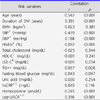1. Zieman SJ, Melenovsky V, Kass DA. Mechanisms, pathophysiology, and therapy of arterial stiffness. Arterioscler Thromb Vasc Biol. 2005; 25:932–943.

2. Laurent S, Cockcroft J, Van Bortel L, Boutouyrie P, Giannattasio C, Hayoz D, Pannier B, Vlachopoulos C, Wilkinson I, Struijker-Boudier H. European Network for Non-invasive Investigation of Large Arteries. Expert consensus document on arterial stiffness: methodological issues and clinical applications. Eur Heart J. 2006; 27:2588–2605.

3. Ruan L, Chen W, Srinivasan SR, Xu J, Sun M, Toprak A, Berenson GS. Relation of plasma homocysteine to arterial stiffness in black and white young adults (from the Bogalusa Heart Study). Am J Cardiol. 2009; 103:985–988.

4. Lieb W, Larson MG, Benjamin EJ, Yin X, Tofler GH, Selhub J, Jacques PF, Wang TJ, Vita JA, Levy D, Vasan RS, Mitchell GF. Multimarker approach to evaluate correlates of vascular stiffness: the Framingham Heart Study. Circulation. 2009; 119:37–43.

5. Cacciapuoti F. Hyper-homocysteinemia: a novel risk factor or a powerful marker for cardiovascular diseases? Pathogenetic and therapeutical uncertainties. J Thromb Thrombolysis. 2011; 32:82–88.

6. de Bree A, Mennen LI, Zureik M, Ducros V, Guilland JC, Nicolas JP, Emery-Fillon N, Blacher J, Hercberg S, Galan P. Homocysteine is not associated with arterial thickness and stiffness in healthy middle-aged French volunteers. Int J Cardiol. 2006; 113:332–340.

7. Woodside JV, McMahon R, Gallagher AM, Cran GW, Boreham CA, Murray LJ, Strain JJ, McNulty H, Robson PJ, Brown KS, Whitehead AS, Savage M, Young IS. Total homocysteine is not a determinant of arterial pulse wave velocity in young healthy adults. Atherosclerosis. 2004; 177:337–344.

8. Anan F, Masaki T, Umeno Y, Yonemochi H, Eshima N, Saikawa T, Yoshimatsu H. Correlations between homocysteine levels and atherosclerosis in Japanese type 2 diabetic patients. Metabolism. 2007; 56:1390–1395.

9. Levy D, Hwang SJ, Kayalar A, Benjamin EJ, Vasan RS, Parise H, Larson MG, Wang TJ, Selhub J, Jacques PF, Vita JA, Keyes MJ, Mitchell GF. Associations of plasma natriuretic peptide, adrenomedullin, and homocysteine levels with alterations in arterial stiffness: the Framingham Heart Study. Circulation. 2007; 115:3079–3085.

10. Davies L, Wilmshurst EG, McElduff A, Gunton J, Clifton-Bligh P, Fulcher GR. The relationship among homocysteine, creatinine clearance, and albuminuria in patients with type 2 diabetes. Diabetes Care. 2001; 24:1805–1809.

11. Buysschaert M, Dramais AS, Wallemacq PE, Hermans MP. Hyperhomocysteinemia in type 2 diabetes: relationship to macroangiopathy, nephropathy, and insulin resistance. Diabetes Care. 2000; 23:1816–1822.

12. Welch GN, Loscalzo J. Homocysteine and atherothrombosis. N Engl J Med. 1998; 338:1042–1050.

13. Fay WP. Homocysteine and thrombosis: guilt by association? Blood. 2012; 119:2977–2978.

14. Weiss N. Mechanisms of increased vascular oxidant stress in hyperhomocys-teinemia and its impact on endothelial function. Curr Drug Metab. 2005; 6:27–36.

15. Steed MM, Tyagi SC. Mechanisms of cardiovascular remodeling in hyperhomocysteinemia. Antioxid Redox Signal. 2011; 15:1927–1943.

16. Gori AM, Corsi AM, Fedi S, Gazzini A, Sofi F, Bartali B, Bandinelli S, Gensini GF, Abbate R, Ferrucci L. A proinflammatory state is associated with hyperhomocysteinemia in the elderly. Am J Clin Nutr. 2005; 82:335–341.

17. Jacobs RL, House JD, Brosnan ME, Brosnan JT. Effects of streptozotocin-induced diabetes and of insulin treatment on homocysteine metabolism in the rat. Diabetes. 1998; 47:1967–1970.

18. Ratnam S, Maclean KN, Jacobs RL, Brosnan ME, Kraus JP, Brosnan JT. Hormonal regulation of cystathionine beta-synthase expression in liver. J Biol Chem. 2002; 277:42912–42918.
19. Dicker-Brown A, Fonseca VA, Fink LM, Kern PA. The effect of glucose and insulin on the activity of methylene tetrahydrofolate reductase and cystathionine-betasynthase: studies in hepatocytes. Atherosclerosis. 2001; 158:297–301.

20. Mazza A, Bossone E, Mazza F, Distante A. Reduced serum homocysteine levels in type 2 diabetes. Nutr Metab Cardiovasc Dis. 2005; 15:118–124.

21. Ndrepepa G, Kastrati A, Braun S, Koch W, Kölling K, Mehilli J, Schömig A. Circulating homocysteine levels in patients with type 2 diabetes mellitus. Nutr Metab Cardiovasc Dis. 2008; 18:66–73.

22. Doupis J, Eleftheriadou I, Kokkinos A, Perrea D, Pavlatos S, Gonis A, Katsilambros N, Tentolouris N. Acute hyperhomocysteinemia impairs endothelium function in subjects with type 2 diabetes mellitus. Exp Clin Endocrinol Diabetes. 2010; 118:453–458.

23. Chico A, Pérez A, Córdoba A, Arcelús R, Carreras G, de Leiva A, González-Sastre F, Blanco-Vaca F. Plasma homocysteine is related to albumin excretion rate in patients with diabetes mellitus: a new link between diabetic nephropathy and cardiovascular disease? Diabetologia. 1998; 41:684–693.

24. Poduri A, Kaur J, Thakur JS, Kumari S, Jain S, Khullar M. Effect of ACE inhibitors and beta-blockers on homocysteine levels in essential hypertension. J Hum Hypertens. 2008; 22:289–294.

25. Atar I, Korkmaz ME, Demircan S, Atar IA, Bozbaş H, Aydinalp A, Ozin B, Yildirir A, Müderrisoğlu H. Beta blocker effects on plasma homocysteine levels in patients with hypertension. Atherosclerosis. 2005; 181:399–402.

26. Shargorodsky M, Boaz M, Pasternak S, Hanah R, Matas Z, Fux A, Beigel Y, Mashavi M. Serum homocysteine, folate, vitamin B12 levels and arterial stiffness in diabetic patients: which of them is really important in atherogenesis? Diabetes Metab Res Rev. 2009; 25:70–75.

27. Khoshdel AR, Carney SL, Trevillian P, Gillies A. Evaluation of arterial stiffness and pulse wave reflection for cardiovascular risk assessment in diabetic and nondiabetic kidney transplant recipients. Iran J Kidney Dis. 2010; 4:237–243.








 PDF
PDF ePub
ePub Citation
Citation Print
Print


 XML Download
XML Download